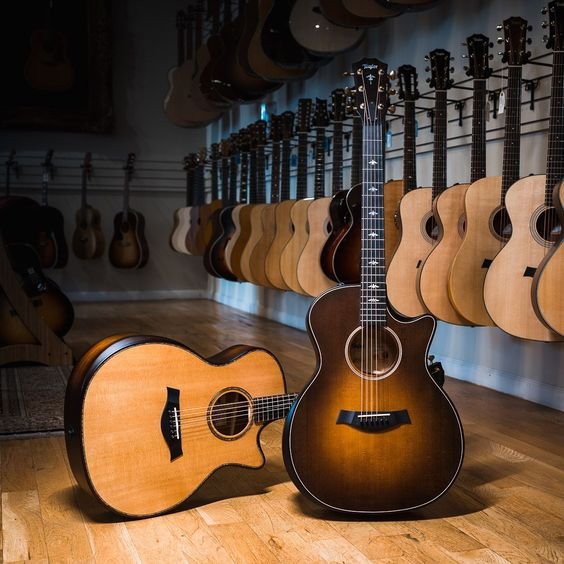The Saga of Chords and Tunes : Birth of Guitar

ORIGIN OF THE GUITAR
The guitar is a plucked string instrument that has its origins in ancient civilizations. The earliest known forms of the guitar are believed to have originated in the eastern Mediterranean and Mesopotamian regions, around 4000 BC. These early guitars were known as “lutes” and were made from hollowed-out wood and had long necks with frets. Over time, the lute evolved and spread to other parts of the world, including Europe and the Americas.
In the Middle Ages, the lute became a popular instrument in Europe and was used in both secular and religious music. During the Renaissance period, the lute underwent further development and evolved into the Baroque guitar. The Baroque guitar had a smaller body and more strings than the lute, and it was used primarily as an accompanying instrument.

The modern guitar as we know it today has its origins in the 18th century. Antonio Torres, a Spanish guitar maker, developed a new design for the guitar that featured a larger body and a more powerful sound. This design, known as the Torres guitar, became the standard for the modern guitar, and it is still used as the basis for most acoustic guitar designs today.
In the 20th century, the electric guitar was developed and became a staple of popular music. Today, the guitar is one of the most widely played instruments in the world, with a rich history and tradition that spans thousands of years.
HOW GUITAR IS MADE
The process of making a guitar varies depending on the type of guitar and the manufacturer, but generally, it involves several steps:
- Wood selection: The first step in making a guitar is selecting the wood. Different types of wood have different properties that affect the sound and tone of the guitar. For example, a guitar made of mahogany will have a warmer, darker tone than one made of maple. The most commonly used woods for guitar making are spruce, cedar, mahogany, rosewood and maple.
- Wood preparation: Once the wood is selected, it is cut, shaped, and dried to the proper humidity level. The wood is then planed and sanded to the desired thickness.
- Assembly: The pieces of wood are then glued together to form the body and neck of the guitar. The shape of the guitar’s body and neck is determined by the manufacturer’s design.
- Frets and bridge installation: After the body and neck are assembled, the frets and bridge are installed. Frets are thin metal strips that are pressed into the fingerboard, and the bridge is a piece of wood or plastic that holds the strings in place.
- Sanding and finishing: Once the frets and bridge are installed, the guitar is sanded and finished. This step involves sanding the guitar to a smooth surface and then applying a finish, such as lacquer or polyurethane, to protect the wood and give the guitar a glossy appearance.
- Stringing up: Finally, the strings are installed and tuned to the proper pitch.

It’s worth noting that some manufacturers use different techniques or materials, and the process can vary depending on the type of guitar that is being built. This is a general overview of the process, but depending on the type of guitar and manufacturer, there might be additional steps or variations in the process.
SEVERAL TYPES OF GUITAR
There are many different types of guitars, each with its own unique characteristics and sound. Some of the most common types include:
- Acoustic guitar: An acoustic guitar is a guitar that uses only an acoustic soundboard to help transmit the string’s energy into the air in order to produce its sound. They come in different shapes and sizes and are used in various genres of music like folk, country, pop, and rock.
- Electric guitar: An electric guitar uses pickups and an amplifier to produce sound. They often have a solid body and are used in genres such as rock, blues, and jazz.
- Classical guitar: Also known as a Spanish guitar, it has nylon strings and a wider neck than other types of guitars. They are used primarily to play classical and flamenco music.
- Steel-string guitar: Steel-string guitars are similar to acoustic guitars, but have steel strings instead of nylon. They have a brighter and louder sound and are used in genres like folk, country, and rock.

- Bass guitar: A bass guitar is similar to an electric guitar, but has a longer neck and thicker strings. It is played with a plucking technique and is used to provide the low-frequency foundation of a song.
- Resonator guitar: A resonator guitar uses a metal resonator to amplify the sound. They have a distinctive twangy sound and are used in genres like blues, country, and bluegrass.
- Archtop guitar: Archtop guitars have a distinctive arched top and are used in jazz, blues and other styles of music.
These are just some of the many different types of guitars that are available, and within each type, there are many variations and sub-types with different features and designs.

FEATURE OF GUITAR
Guitars has several features that make them unique and distinguishable from one another. Some of the most common features of a guitar include
- Body: The body of a guitar refers to the main section of the instrument that houses the soundboard and other components. The shape and size of the body can affect the sound and tone of the guitar.
- Neck: The neck of a guitar is the long, thin piece of wood that connects the body to the headstock. The neck is typically made of wood, and it contains frets, which are used to play different notes on the guitar.
- Headstock: The headstock is the top of the guitar, where the strings are attached. It also contains the tuning pegs, which are used to tune the guitar.
- Fretboard: The fretboard is the flat surface on the front of the neck, where the frets are located. It is typically made of wood, and it is used to play different notes on the guitar.
- Strings: The strings of a guitar are the thin wires that are stretched across the body of the instrument. They are plucked or strummed to produce sound.
- Bridge: The bridge is a piece of wood or plastic that holds the strings in place and transfers the vibrations of the strings to the soundboard.
- Soundhole: The soundhole is an opening in the body of the guitar that allows sound to travel out of the instrument.
- Pickups: Electric guitars have pickups, which are devices that convert the vibrations of the strings into electrical signals. These signals are then amplified by an amplifier to produce sound.
- Hardware: Hardware refers to all the other mechanical parts of the guitar, such as the tuners, the nut, and the tailpiece.

These are the most common features of a guitar, but different types of guitars may have different features or variations of these basic elements.
LIST OF FAMOUS MUSICIANS OF GUITAR
There are countless famous musicians throughout history, but here is a list of some notable ones across different genres:
- The Beatles: A British rock band formed in Liverpool in 1960, widely considered one of the most influential bands of all time.
- Bob Dylan: An American singer-songwriter, artist and writer, he has been a major figure in popular music for more than five decades.
- Michael Jackson: An American singer, songwriter, and dancer, who is regarded as one of the most significant cultural figures of the 20th century.
- Elvis Presley: An American singer and actor, referred to as the “King of Rock and Roll” and one of the most significant cultural icons of the 20th century.
- Freddie Mercury: A British singer, songwriter, and record producer, best known as the lead vocalist of the rock band Queen.
- Beethoven: A German composer and pianist, widely considered the greatest composer who ever lived.
- Miles Davis: An American jazz trumpeter, bandleader, and composer, he is among the most influential and acclaimed figures in the history of jazz.
- Louis Armstrong: An American trumpeter, composer, singer and occasional actor who was one of the most influential figures in jazz.
- Bob Marley: A Jamaican singer-songwriter and musician, he is considered one of the pioneers of reggae music.
- Aretha Franklin: An American singer, songwriter, pianist, and civil rights activist, she is one of the most legendary figures in the history of American popular music.

This list is by no means exhaustive and there are many other famous musicians and bands who have contributed to the music industry across different genres and eras.
CURRENT SCENARIO
As of 2021, the guitar remains a popular instrument in many different genres of music, from rock and pop to country, jazz, and blues. Electric and acoustic guitars are both widely used in a variety of settings, from live performances to studio recordings.
In recent years, there has been a renewed interest in guitar-driven music, with many young musicians picking up the instrument and forming new bands. This has led to a resurgence of guitar-heavy genres like rock and metal, with many new bands drawing inspiration from classic acts of the past.
Additionally, advances in technology have made it easier for guitar players to create and share music online. Social media platforms have provided new opportunities for guitarists to connect with other musicians, share their work, and build fan bases.
In terms of guitar manufacturing, companies are now producing guitars with new materials, and designs and even with the use of technology which makes the guitar easier to play, producing unique sound and accessible to more players.
Overall, the guitar remains an important and enduring part of the music landscape, with a new generation of players keeping the tradition alive and pushing the boundaries of what the instrument can do.

CONCLUSION
In conclusion, the guitar is a versatile and enduring instrument that has been a key part of the music landscape for centuries. It remains popular in a wide range of genres, from rock and pop to country, jazz, and blues. With advances in technology and the rise of online platforms, guitar players now have more opportunities than ever to connect with other musicians, share their work, and build fan bases. The guitar has evolved over the years, with new materials, designs and technology being integrated with the manufacturing process to make it easier to play, produce a unique sound and accessible to more players. Overall, the guitar is an important and enduring part of the music industry and will continue to be so in the future.



